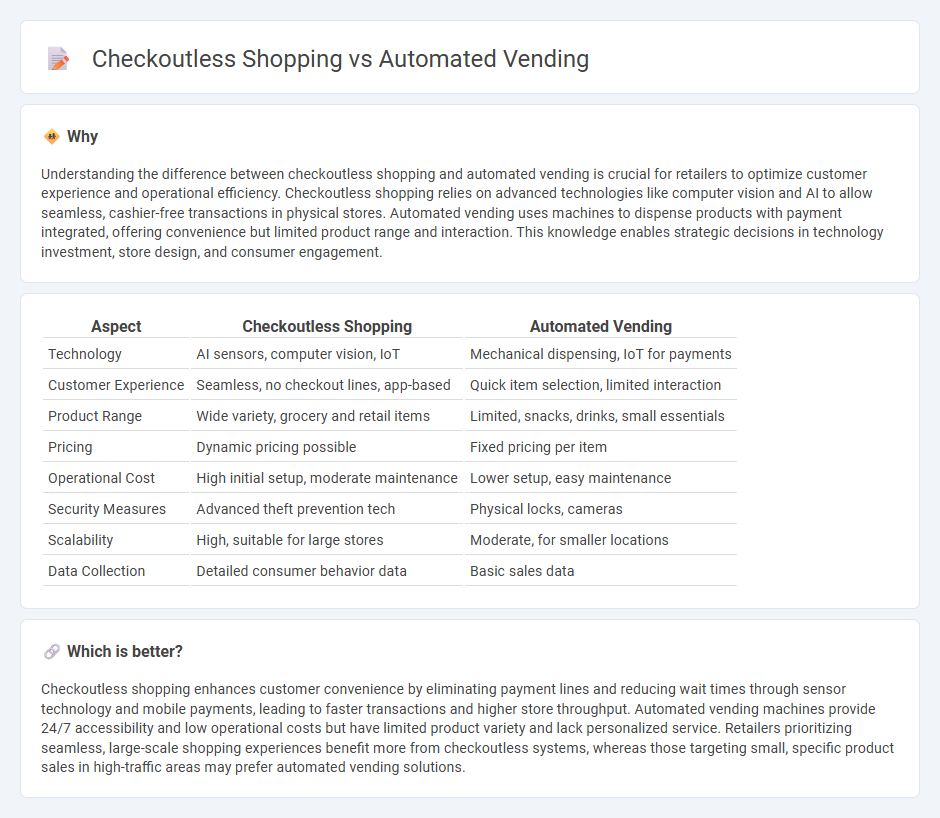
Checkoutless shopping enhances convenience by enabling customers to pick items and leave without traditional payment lines, leveraging technologies like RFID and computer vision for seamless transactions. Automated vending machines provide quick access to products through self-service kiosks, ideal for locations with limited space or staffing. Explore how these innovations are reshaping retail efficiency and customer experience.
Why it is important
Understanding the difference between checkoutless shopping and automated vending is crucial for retailers to optimize customer experience and operational efficiency. Checkoutless shopping relies on advanced technologies like computer vision and AI to allow seamless, cashier-free transactions in physical stores. Automated vending uses machines to dispense products with payment integrated, offering convenience but limited product range and interaction. This knowledge enables strategic decisions in technology investment, store design, and consumer engagement.
Comparison Table
| Aspect | Checkoutless Shopping | Automated Vending |
|---|---|---|
| Technology | AI sensors, computer vision, IoT | Mechanical dispensing, IoT for payments |
| Customer Experience | Seamless, no checkout lines, app-based | Quick item selection, limited interaction |
| Product Range | Wide variety, grocery and retail items | Limited, snacks, drinks, small essentials |
| Pricing | Dynamic pricing possible | Fixed pricing per item |
| Operational Cost | High initial setup, moderate maintenance | Lower setup, easy maintenance |
| Security Measures | Advanced theft prevention tech | Physical locks, cameras |
| Scalability | High, suitable for large stores | Moderate, for smaller locations |
| Data Collection | Detailed consumer behavior data | Basic sales data |
Which is better?
Checkoutless shopping enhances customer convenience by eliminating payment lines and reducing wait times through sensor technology and mobile payments, leading to faster transactions and higher store throughput. Automated vending machines provide 24/7 accessibility and low operational costs but have limited product variety and lack personalized service. Retailers prioritizing seamless, large-scale shopping experiences benefit more from checkoutless systems, whereas those targeting small, specific product sales in high-traffic areas may prefer automated vending solutions.
Connection
Checkoutless shopping and automated vending systems both leverage advanced technologies such as artificial intelligence, computer vision, and IoT sensors to streamline the retail purchasing experience. These innovations reduce or eliminate the need for traditional cashier interactions by enabling automatic product detection, payment processing, and inventory management. The integration of these technologies enhances customer convenience, improves operational efficiency, and supports real-time data analytics in retail environments.
Key Terms
Point-of-Sale (POS) Systems
Automated vending relies on traditional POS systems integrated with inventory sensors to streamline transactions, while checkoutless shopping utilizes advanced POS technology combined with computer vision and AI to enable seamless, cashier-free purchases. Both systems enhance the retail experience by reducing wait times and improving operational efficiency, with automated vending focusing on standalone kiosks and checkoutless shopping implementing sensor networks and mobile payment integration across entire stores. Explore more about how these POS innovations are transforming retail environments and boosting customer satisfaction.
RFID/NFC Technology
Automated vending machines leverage RFID and NFC technology to enable seamless product selection and cashless payment, enhancing user convenience and reducing transaction time. Checkoutless shopping systems utilize similar RFID/NFC sensors embedded in store shelves and carts to automatically detect purchased items and charge customers upon exit, eliminating traditional checkout lines. Discover how RFID and NFC innovations are revolutionizing retail efficiency and customer experience.
Inventory Management
Automated vending machines utilize real-time sensors and cloud-based software to track inventory levels, ensuring timely restocking and minimizing stockouts. Checkoutless shopping employs advanced computer vision and RFID technology for seamless product tracking from shelf to purchase, enabling precise inventory updates and demand forecasting. Explore how these cutting-edge inventory management solutions transform retail efficiency and customer experience.
Source and External Links
Smart Vending Machines: The Future of Automated Retail - T-ROC - Automated vending machines have evolved into AI-driven retail hubs that offer diverse products, cashless payments, real-time inventory tracking, and deliver personalized, convenient shopping experiences around the clock.
Smart Vending & Automated Retail - Silkron - Modern automated vending platforms leverage AI, big data, and remote management over networks like 5G to enable personalized sales strategies, remote telemetry, dynamic pricing, and enhanced user experiences including facial recognition and targeted ads.
Automated Vending Machine - IT Asset Distribution Solutions - Automated vending solutions reduce staffing needs by managing inventory and sales autonomously, provide 24/7 service accessibility, and help businesses expand markets by deploying smart vending machines in strategic locations with minimal operating costs.
 dowidth.com
dowidth.com